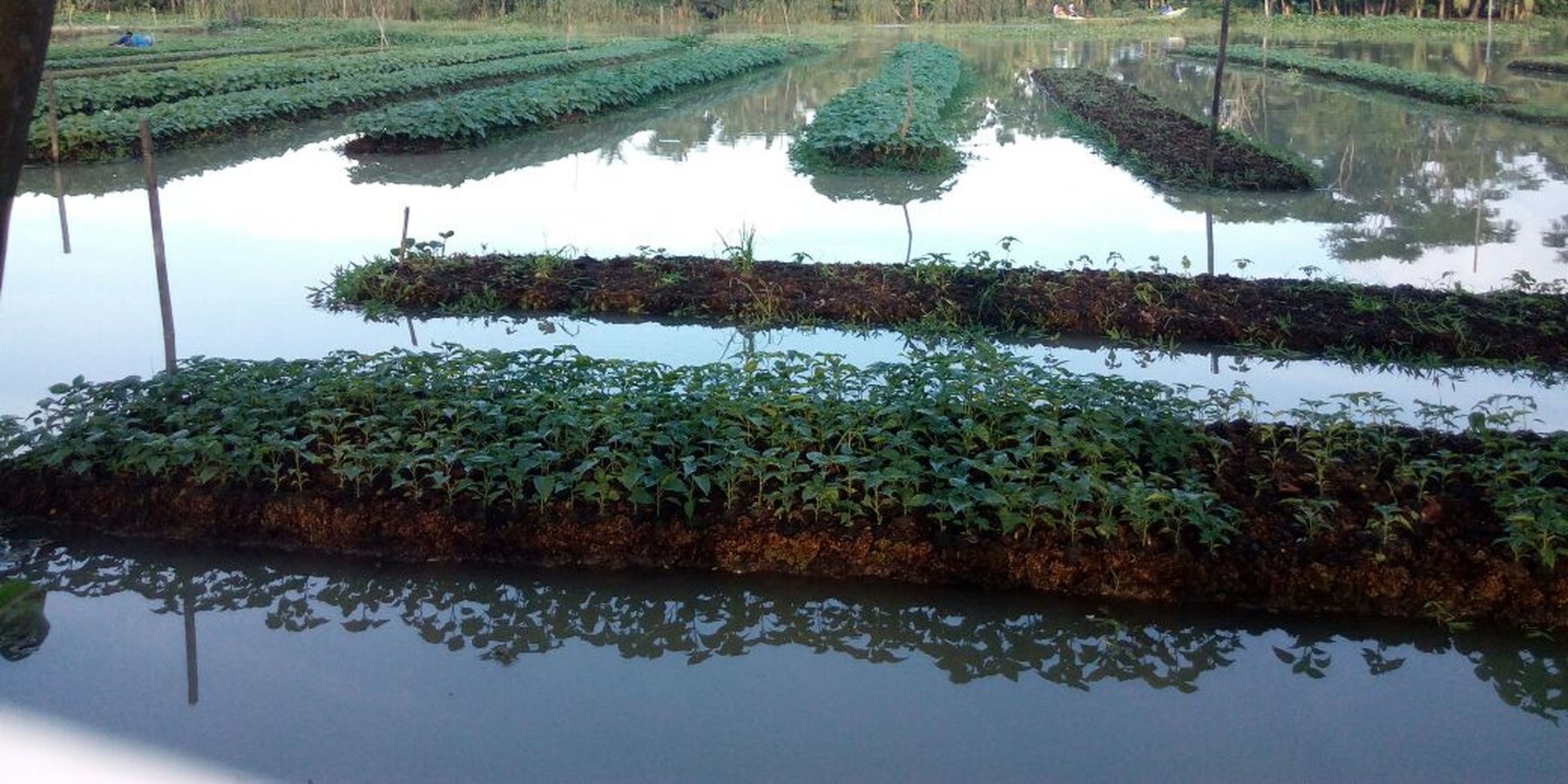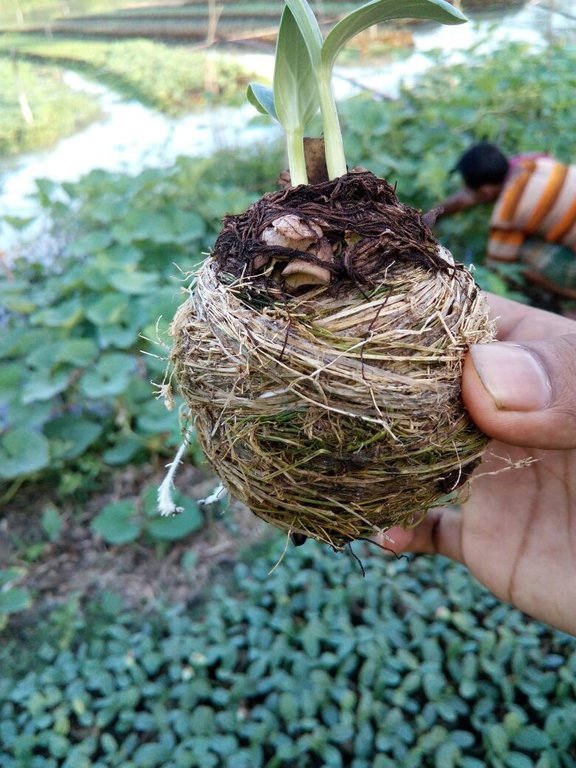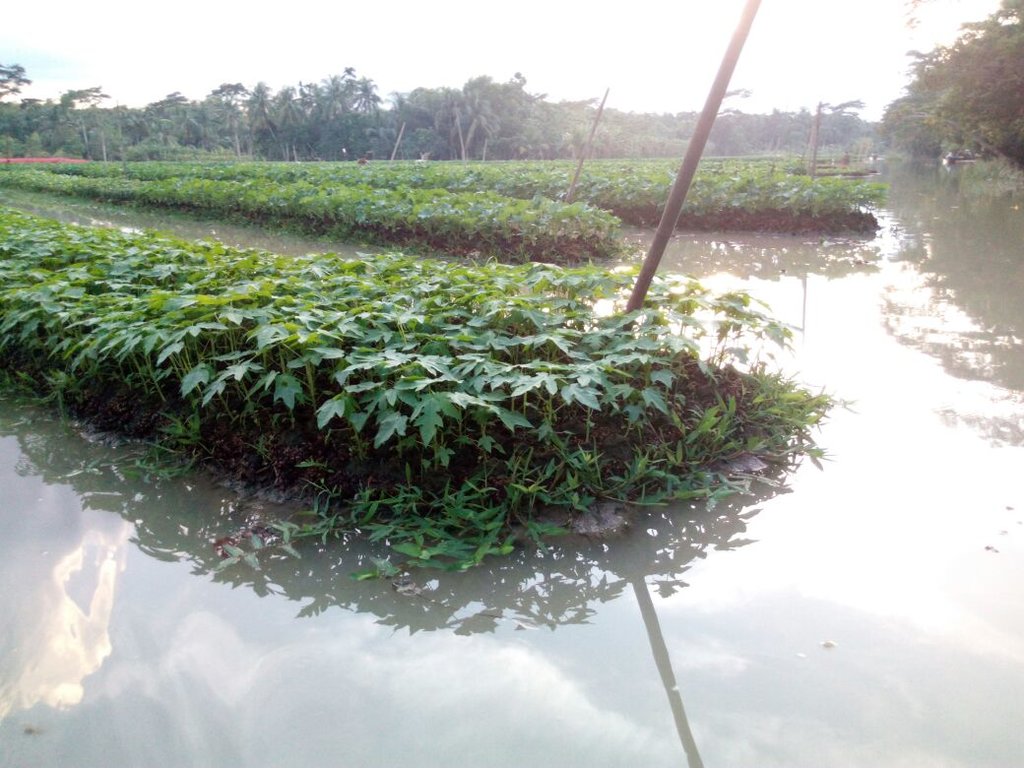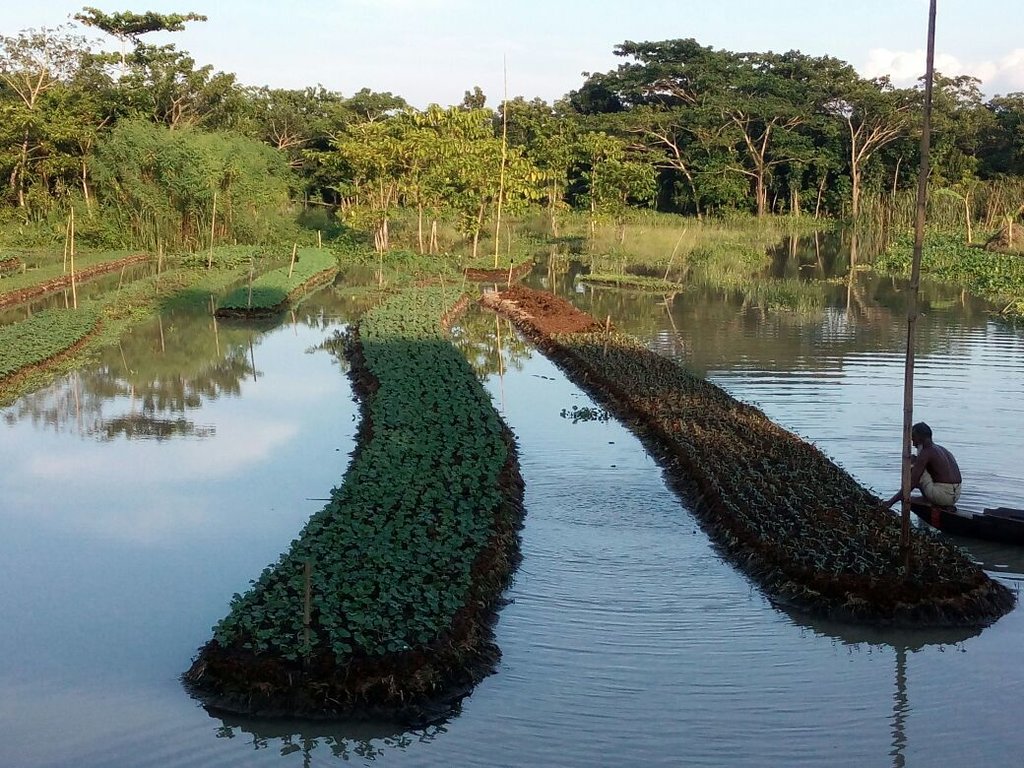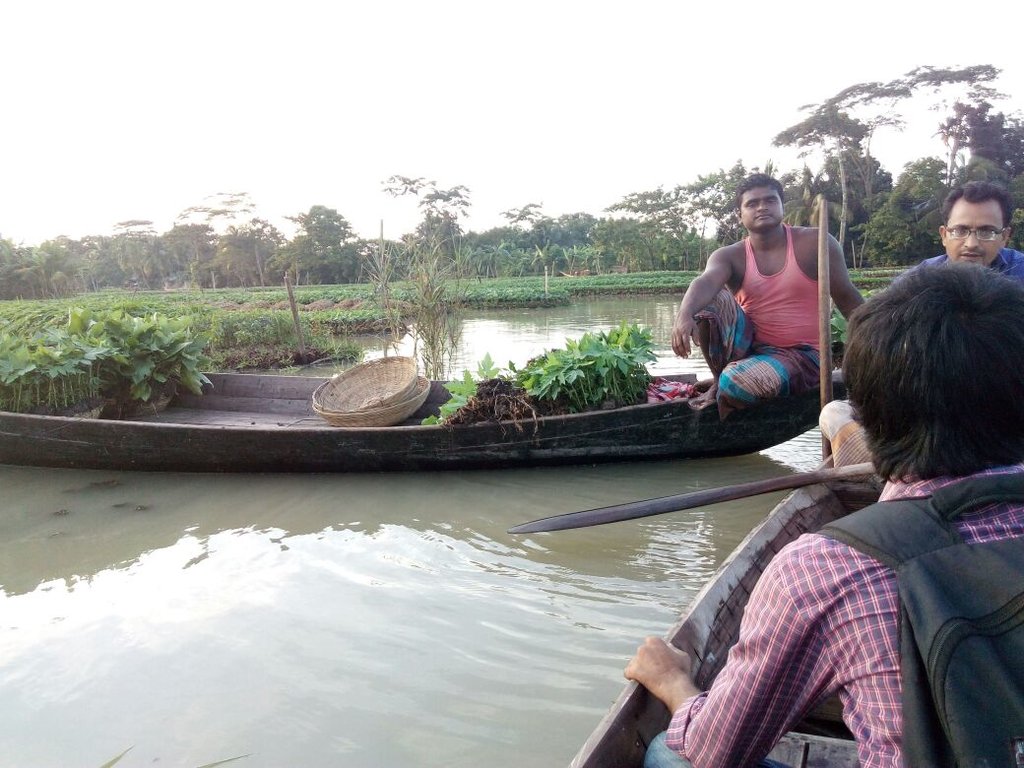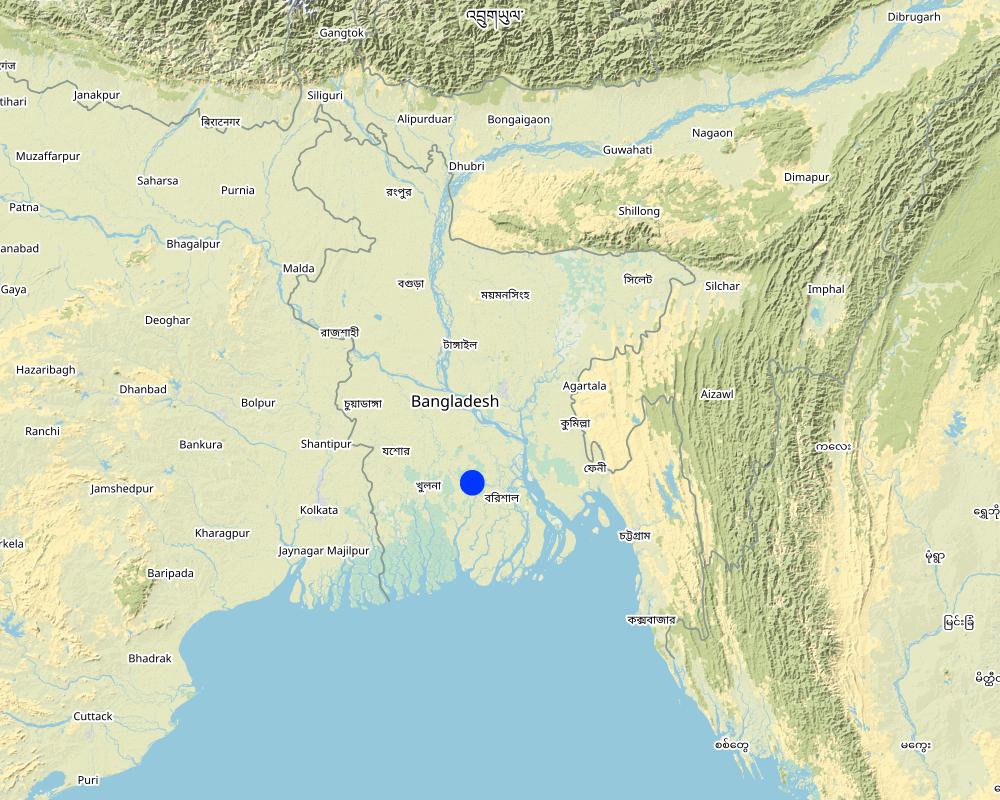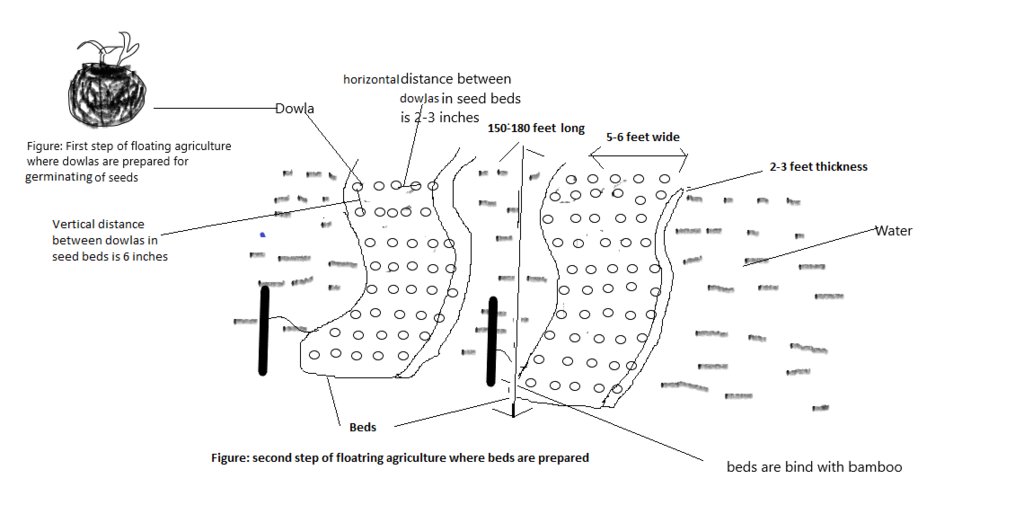FLOATING AGRICULTURE IN WATERLOGGED SOIL [孟加拉国]
- 创建:
- 更新:
- 编制者: Naznin Imrana
- 编辑者: –
- 审查者: Udo Höggel, Rima Mekdaschi Studer
"Dhap poddhoti"
technologies_3619 - 孟加拉国
查看章节
全部展开 全部收起1. 一般信息
1.2 参与该技术评估和文件编制的资源人员和机构的联系方式
有助于对技术进行记录/评估的机构名称(如相关)
University (of Barisal) - 孟加拉国1.3 关于使用通过WOCAT记录的数据的条件
(现场)数据是什么时候汇编的?:
07/04/2017
编制者和关键资源人员接受有关使用通过WOCAT记录数据的条件。:
是
1.4 所述技术的可持续性声明
这里所描述的技术在土地退化方面是否存在问题,导致无法被认为是一种可持续的土地管理技术?:
否
2. SLM技术的说明
2.1 技术简介
技术定义:
The aim of this technology is to use the waterlogged soils, which remain under water during 6 to 7 months of a year, for vegetable seedlings. This is done through floating seed beds which are made of water hyacinths.
2.2 技术的详细说明
说明:
Floating agriculture is a special technique to cultivate vegetables and vegetable seedlings such as Pumpkin, Bean, Brinjal, Cucumber, Tomato, Papaya, Green Chili etc. on waterlogged soils. This is done by using floating seed beds, which are made of water hyacinths and other aquatic plants such as Dulalilata (Hygroryza aristata) Tepapana (Pistia stratiotes) and Khudepana (Lemna spirodela).
Paddy cultivation is usually done from October to April. After the paddy harvest, the lands usually remain waterlogged under 7 to 8 feet of water from May to November. With the onset of the rainy season, these regions are covered with water hyacinths and other aquatic plants etc. Normal agricultural production during this period is not possible due to this waterlogged condition and the growing water hyacinths, Dulalilata, Tepapana etc.
However, floating agriculture enables farmers to use this land in the best productive way. Floating agriculture is started by collecting water plants (Hyacinth, Dulalilata, Tepapana) for preparing floating seedbeds using these plants. This is because the vegetable seeds cannot be sown traditionally into the soil. Hence, a nutritious soft ball is prepared by using Tepapana and Khudepana which is called dowla. A small amount of urea fertilizer is put into each dowla. Thereafter, different types of vegetable seeds are sown / placed, in wet condition, into the dowlas. The dowlas so prepared are kept in an open place for drying / sprouting for 3 to 7 days. Thereafter, the dowlas are placed on the floating seedbed, which have been already made, where each Dowla is placed respecting 6 inches of distance in a bed. In such manner and about 2,450 dowlas can be placed in each seedbed. After taking proper care for one month including irrigation every day to prevent root dry up and fertilisation using a little amount urea fertilizer the sprouting seedlings are getting matured and ready for sale.
The establishment costs for a floating seedbed of 150 -180 feet long is between 3000 to 5500 taka. To make such a floating seedbed, a person must work 6 to 8 or 10 hours on a wage of 250 taka per workday. Nearly 25000 thousand women workers of these regions are directly or indirectly involved in this production. Each worker earns 200 to 250 taka per day. On an average, women can prepare between 1000 to 2000 dowlas per day. In this work, a female worker gets an average of 150 to 200 taka per day. A farmer earns 6-7 thousand taka through one time use of bed by selling seedlings within 20-22 days. The seedbeds can be used at least 3 times for seedling production in a season (May to November). So, it is possible to earn 18000 -20000 taka per bed in a season.
After that, the floating beds can be used again for growing vegetables, thus they are able to grow about ten thousand metric tons of vegetables annually in these regions that meets the local demand. Some vegetables are also sent to other regions /communities, achieving a very beneficial profit. It is possible to earn about 2-3 thousand taka by selling vegetables. After completing all these seedlings and vegetables growing processes seedbeds can be sold for between 1-2 thousand taka to other farmers. Therefore, it is possible to earn 20000-250000 taka per bed in a season including all other sources of income, which are mentioned above.
Storm and other climatic hazards cannot do much harm to this cultivation method. Besides, it is possible to produce vegetables throughout the year.
Using this technology allows people of waterlogged regions to turn their wheel of fortune by cultivating vegetables/vegetable seedlings, hence being able to overcome poverty up to 70%.
2.3 技术照片
2.5 已应用该技术的、本评估所涵盖的国家/地区/地点
国家:
孟加拉国
区域/州/省:
Nazirpur Upazila (upazila means sub unit of a district), Pirojpur District
有关地点的进一步说明:
Gaokhali,Mugarjhor,Bisharkandi,Bildumoria etc
Map
×2.6 实施日期
如果不知道确切的年份,请说明大概的日期:
- 50多年前(传统)
2.7 技术介绍
详细说明该技术是如何引入的:
- 通过土地使用者的创新
3. SLM技术的分类
3.1 该技术的主要目的
- 改良生产
- 创造有益的经济影响
- 创造有益的社会影响
3.2 应用该技术的当前土地利用类型

水道、水体、湿地
- waterlogged area
3.3 有关土地利用的更多信息
该技术所应用土地的供水:
- 雨养
每年的生长季节数:
- 1
3.4 该技术所属的SLM组
- 湿地保护/管理
3.5 技术传播
具体说明该技术的分布:
- 适用于特定场所/集中在较小区域
注释:
This technology is applicable for some specific regions (Banaripara, Agailjhara Ujirpur, Pirojpur’s Nazirpur and Swarupkathi Upazila), as they remain waterlogged from May to October.
3.6 包含该技术的可持续土地管理措施

农艺措施
- A1:植被和土壤覆盖层

结构措施
- S11:其它

管理措施
- M1:改变土地使用类型
3.8 防止、减少或恢复土地退化
具体数量名该技术与土地退化有关的目标:
- 不适用
4. 技术规范、实施活动、投入和成本
4.1 该技术的技术图纸
4.2 技术规范/技术图纸说明
Seed bed and construction material:
-Dimensions: 150 to 180 feet long, 5-6 feet width and thickness 2 to 3 ft.
-Horizontal spacing between structures or plants / vegetative measures (dowlas) : 2-3 inches
-Vertical intervals between structures or vegetative measures: 6 inches
The seedbed consists of floating carpets of water hyacinth, dulalilata (Hygroryza aristata), tepapana (Pistia stratiotes) and other aquatic plants.
Dowla and construction material:
Dowlas are constructed by using tepapana (Pistia stratiotes) and khudepana (Lemna spirodela) water plants that are rolled into a soft ball. The density of dowlas within a seedbed is 2450 seedlings.
4.3 有关投入和成本计算的一般信息
具体说明成本和投入是如何计算的:
- 每个技术区域
注明尺寸和面积单位:
approx. 750 sq feet (70 m2)
如果使用本地面积单位,请注明换算系数为1公顷:
1 ha = 107639 sq feet
其它/国家货币(具体说明):
Taka
注明美元与当地货币的汇率(如相关):1美元=:
82.7344
注明雇用劳工的每日平均工资成本:
250 taka
4.4 技术建立活动
| 活动 | 措施类型 | 时间 | |
|---|---|---|---|
| 1. | Dowla | 农业学的 | May to November |
| 2. | Seed bed | 农业学的 | May to November |
| 3. | Planting of dowlas into seedbeds | 农业学的 | May to November |
4.5 技术建立所需要的费用和投入
| 对投入进行具体说明 | 单位 | 数量 | 单位成本 | 每项投入的总成本 | 土地使用者承担的成本% | |
|---|---|---|---|---|---|---|
| 劳动力 | Seedbed of 150 to 180 feet long | labour/per bed | 3.0 | 250.0 | 750.0 | 100.0 |
| 劳动力 | Dowla | labour/2450 dowla | 2.0 | 200.0 | 400.0 | 100.0 |
| 植物材料 | Seed (e.g. pumpkin) | kg | 2.0 | 400.0 | 800.0 | 100.0 |
| 肥料和杀菌剂 | Urea | kg | 1.0 | 16.0 | 16.0 | 100.0 |
| 施工材料 | Water hyacinth | ton | 5.0 | 200.0 | 1000.0 | 100.0 |
| 施工材料 | Dulalilata (Hygroryza aristata) | ton | 2.0 | 500.0 | 1000.0 | 100.0 |
| 施工材料 | Tepapana (Pistia stratiotes) | ton | 3.0 | 333.0 | 999.0 | 100.0 |
| 施工材料 | Khudepana (Lemna spirodela) | ton | 0.5 | 1000.0 | 500.0 | 100.0 |
| 技术建立所需总成本 | 5465.0 | |||||
4.6 维护/经常性活动
| 活动 | 措施类型 | 时间/频率 | |
|---|---|---|---|
| 1. | Watch and ward | 管理 | May to November |
4.7 维护/经常性活动所需要的费用和投入(每年)
| 对投入进行具体说明 | 单位 | 数量 | 单位成本 | 每项投入的总成本 | 土地使用者承担的成本% | |
|---|---|---|---|---|---|---|
| 劳动力 | Watch and ward | per bed | 2.0 | 200.0 | 400.0 | 100.0 |
| 技术维护所需总成本 | 400.0 | |||||
4.8 影响成本的最重要因素
描述影响成本的最决定性因素:
Labor cost, price of seed and price of urea fertilizer, Dulalilata (Hygroryza aristata), Tepapana (Pistia stratiotes) and Khudepana (Lemna spirodela)
5. 自然和人文环境
5.1 气候
年降雨量
- < 250毫米
- 251-500毫米
- 501-750毫米
- 751-1,000毫米
- 1,001-1,500毫米
- 1,501-2,000毫米
- 2,001-3,000毫米
- 3,001-4,000毫米
- > 4,000毫米
农业气候带
- 潮湿的
5.2 地形
平均坡度:
- 水平(0-2%)
- 缓降(3-5%)
- 平缓(6-10%)
- 滚坡(11-15%)
- 崎岖(16-30%)
- 陡峭(31-60%)
- 非常陡峭(>60%)
地形:
- 高原/平原
- 山脊
- 山坡
- 山地斜坡
- 麓坡
- 谷底
垂直分布带:
- 0-100 m a.s.l.
- 101-500 m a.s.l.
- 501-1,000 m a.s.l.
- 1,001-1,500 m a.s.l.
- 1,501-2,000 m a.s.l.
- 2,001-2,500 m a.s.l.
- 2,501-3,000 m a.s.l.
- 3,001-4,000 m a.s.l.
- > 4,000 m a.s.l.
说明该技术是否专门应用于:
- 不相关
5.3 土壤
平均土层深度:
- 非常浅(0-20厘米)
- 浅(21-50厘米)
- 中等深度(51-80厘米)
- 深(81-120厘米)
- 非常深(> 120厘米)
土壤质地(表土):
- 中粒(壤土、粉土)
- 细粒/重质(粘土)
表土有机质:
- 低(<1%)
5.4 水资源可用性和质量
地下水位表:
< 5米
水质(未处理):
仅供农业使用(灌溉)
水的盐度有问题吗?:
否
该区域正在发生洪水吗?:
否
关于水质和水量的注释和进一步规范:
Waterlogged condition promote the excessive growth of water hyacinths thus causing water pollution
5.5 生物多样性
物种多样性:
- 中等
栖息地多样性:
- 中等
5.6 应用该技术的土地使用者的特征
生产系统的市场定位:
- 商业/市场
非农收入:
- 收入的10-50%
相对财富水平:
- 非常贫瘠
- 贫瘠
个人或集体:
- 个人/家庭
机械化水平:
- 手工作业
性别:
- 女人
- 男人
5.7 应用该技术的土地使用者拥有或租用的平均土地面积
- < 0.5 公顷
- 0.5-1 公顷
- 1-2 公顷
- 2-5公顷
- 5-15公顷
- 15-50公顷
- 50-100公顷
- 100-500公顷
- 500-1,000公顷
- 1,000-10,000公顷
- > 10,000公顷
这被认为是小规模、中规模还是大规模的(参照当地实际情况)?:
- 小规模的
5.8 土地所有权、土地使用权和水使用权
土地所有权:
- 个人,有命名
土地使用权:
- 租赁
- 个人
用水权:
- 租赁
5.9 进入服务和基础设施的通道
健康:
- 贫瘠
- 适度的
- 好
教育:
- 贫瘠
- 适度的
- 好
技术援助:
- 贫瘠
- 适度的
- 好
就业(例如非农):
- 贫瘠
- 适度的
- 好
市场:
- 贫瘠
- 适度的
- 好
能源:
- 贫瘠
- 适度的
- 好
道路和交通:
- 贫瘠
- 适度的
- 好
饮用水和卫生设施:
- 贫瘠
- 适度的
- 好
金融服务:
- 贫瘠
- 适度的
- 好
6. 影响和结论性说明
6.1 该技术的现场影响
社会经济效应
生产
作物生产
注释/具体说明:
Best use of water hyacinths and barren waterlogged soil
收入和成本
农业投入费用
注释/具体说明:
No heavy machinery or costly fertilizers is used in this technology. In this technology, farmers cultivate crops in a simple way using water hyacinths which is a great source of organic fertilizer.
社会文化影响
食品安全/自给自足
文化机会
注释/具体说明:
Spiritual, aesthetics and other cultural opportunities are improved by the cash from vegetables.
娱乐机会
注释/具体说明:
Tourist people are attracted by the green beauty of waterlogged areas when the fields are full of different crops. Tourists can also make a boat trip during raniy season when the areas expand into a board shallow sheets of water.
社区机构
注释/具体说明:
Socioeconomic conditions of people in waterlogged areas where this technology is being used for crop production, have improved.
国家机构
生态影响
水循环/径流
多余水的排放
注释/具体说明:
As at least 5 to 6 months the soil remains in waterlogged condition so there is very less possibility to excess water drainage
地下水位/含水层
注释/具体说明:
This land acts as recharge areas holding and storing the surface water and allowing it to percolate down through the soil and rock to the ground water
土壤
土壤水分
注释/具体说明:
In waterlogged soil the soil pores are filled with water hence, it increases soil moisture
减少气候和灾害风险
洪水影响
注释/具体说明:
Waterlogged areas collect, store and hold flood waters and ultimately control and reduce flood damage
6.3 技术对渐变气候以及与气候相关的极端情况/灾害的暴露和敏感性(土地使用者认为的极端情况/灾害)
渐变气候
渐变气候
| 季节 | 气候变化/极端天气的类型 | 该技术是如何应对的? | |
|---|---|---|---|
| 年温度 | 增加 | 不好 |
气候有关的极端情况(灾害)
气象灾害
| 该技术是如何应对的? | |
|---|---|
| 局地暴雨 | 不好 |
| 局地风暴 | 不好 |
6.4 成本效益分析
技术收益与技术建立成本相比如何(从土地使用者的角度看)?
短期回报:
非常积极
长期回报:
积极
技术收益与技术维护成本/经常性成本相比如何(从土地使用者的角度看)?
短期回报:
非常积极
长期回报:
积极
6.5 技术采用
- 大于 50%
在所有采用这项技术的人当中,有多少人是自发地采用该技术,即未获得任何物质奖励/付款?:
- 90-100%
6.6 适应
最近是否对该技术进行了修改以适应不断变化的条件?:
否
6.7 该技术的优点/长处/机会
| 土地使用者眼中的长处/优势/机会 |
|---|
| Early production of seedling of vegetables |
| Increase vegetables supply in waterlogged area |
| Highly resistant to pest |
| Crops require shorter time to mature when cultivated in floating platforms |
| Require very less amount of fertilizer and pesticide |
| 编制者或其他关键资源人员认为的长处/优势/机会 |
|---|
| Prime nutrient elements such as nitrogen, potassium and phosphorus are available in water hyacinth and other aquatic plant so no need to supplement for plant growth |
| It is the best utilization of water-logged land |
| After harvesting of vegetables the seedbeds gradually start to decompose which, are an immense source of organic matter. Thus the soil quality is improved. |
| It improves the socio-economic conditions of the farmers of the water-logged area |
| Eco friendly |
| It is the best use of water hyacinths which otherwise cause water pollution and destroy the aquatic ecosystem |
6.8 技术的弱点/缺点/风险及其克服方法
| 土地使用者认为的弱点/缺点/风险 | 如何克服它们? |
|---|---|
| Shortage of financial supports | Need more financial help to execute this technique from different organizations |
| Farmers get difficulties to get loan | Ensure easy loan facilities with less interest |
| Sometimes seed and fertilizer price goes so high that farmers couldn't afford buying | So, in this perspective they need free marketing of seed and fertilizer |
| Lack of quality seeds | Ensure quality seeds by establishing Bangladesh Agricultural DC seed sell center in the area |
| Improved Governmental and Non governmental agricultural organizations involvement | Governmental and Non governmental agricultural organization should come forward in this perspective for providing additional help to the farmers |
| 编制者或其他关键资源人员认为的弱点/缺点/风险 | 如何克服它们? |
|---|---|
| Lack of expert persons | Need more expert persons to spread the skill about this technique among the farmers |
| Lack of knowledge in use of water hyacinth | Spread the knowledge about beneficial used of water hyacinth |
| Fraud market | Minimize the violence of intermediate fraud market as for this farmers are deprived of their attainable price |
7. 参考和链接
7.1 信息的方法/来源
- 实地考察、实地调查
3
- 与土地使用者的访谈
3
7.2 参考可用出版物
标题、作者、年份、ISBN:
Floating Garden Practices
可以从哪里获得?成本如何?
www.fao.org/giahs/giahsaroundtheworld/designated-sites/asia-and-the-pacific/floating-garden-agricultural-practices/detailed-information/en/
标题、作者、年份、ISBN:
Floating Bed Cultivation and Gardening in Bangladesh
可以从哪里获得?成本如何?
http://www.ideassonline.org/public/pdf/FloatingGardensBangladesh-ENG.pdf
标题、作者、年份、ISBN:
Floating vegetable farming boon for marginal farmers; S Dilip Roy; Daily Star; 2012
可以从哪里获得?成本如何?
https://www.thedailystar.net/news-detail-217543
标题、作者、年份、ISBN:
Floating agricultural systems
可以从哪里获得?成本如何?
https://www.ctc-n.org/sites/www.ctc-n.org/files/resources/floating_agricultural_systems.pdf
标题、作者、年份、ISBN:
Floating Garden Agricultural Practices
可以从哪里获得?成本如何?
http://www.fao.org/giahs/giahsaroundtheworld/designated-sites/asia-and-the-pacific/floating-garden-agricultural-practices/detailed-information/en/
链接和模块
全部展开 全部收起链接
无链接
模块
无模块


